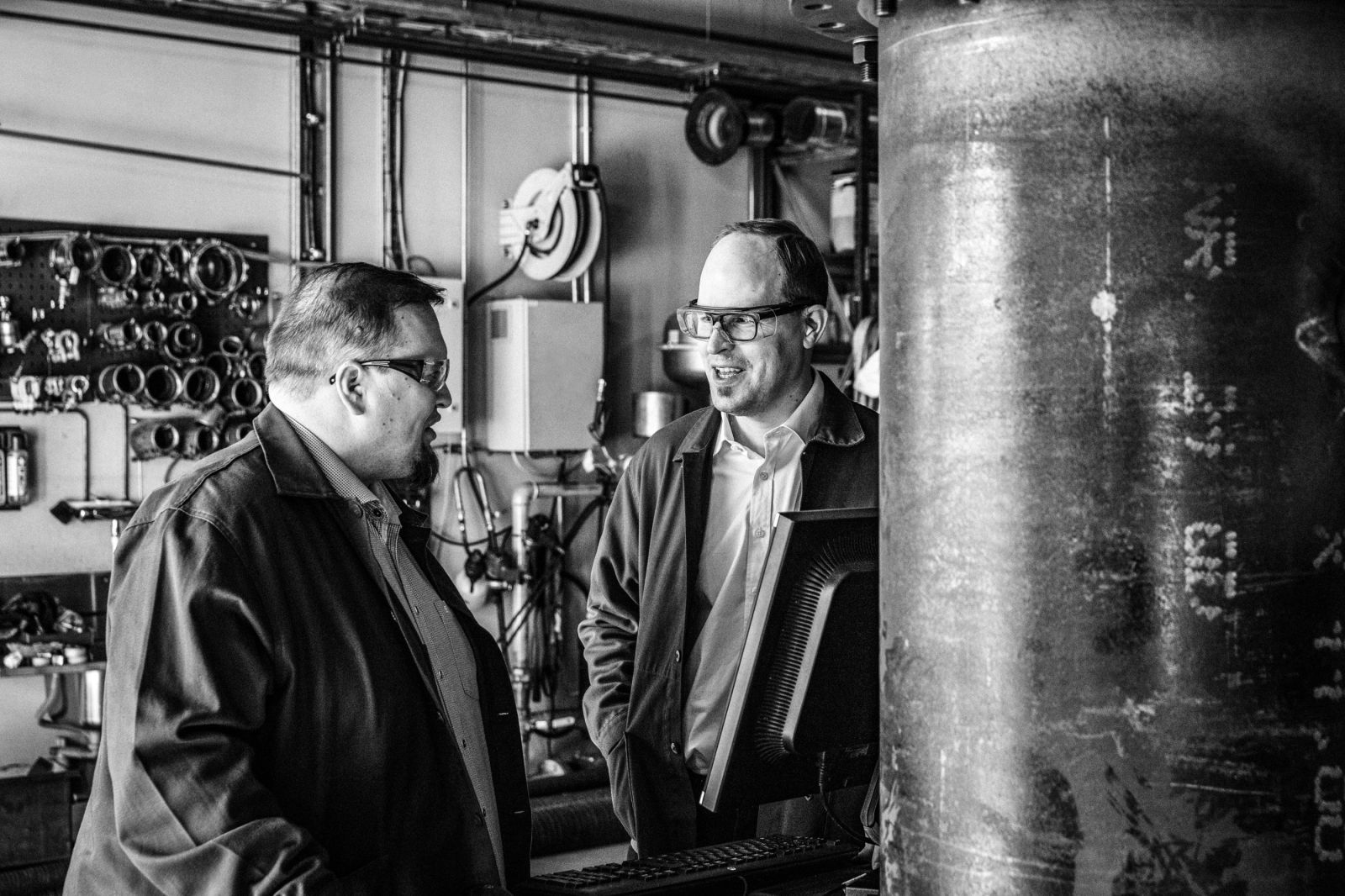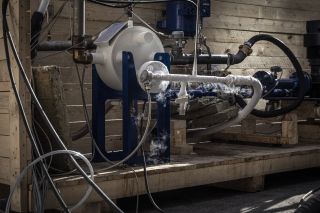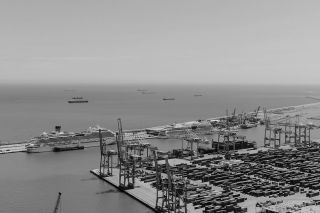LNG Market Outlook – The Future Is Bright on Land and on Sea
Versatile and easy to transport, LNG is an increasingly popular fuel both in marine and onshore applications. Besides energy, LNG is used as a raw material in chemical processes, and its full potential is being unleashed through heat transfer and cold recovery.
Frans Launonen, Key Account Manager at Vahterus
In January 1959, over 60 years ago, the world’s first LNG ocean cargo was shipped from Lake Charles, Louisiana, USA, to Canvey Island in England. The vessel herself, a ‘methane pioneer’, was retrofitted from cargo ship to 32,000 barrel LNG tanker (the equivalent of a 5,000 CBM LNG bunker vessel today). Its mission was to demonstrate to the world that LNG could be transported safe and sound – even over longer distances.
There are two key reasons why LNG is now being used globally: firstly, when changed from gas to liquid at ambient pressure, LNG takes up 600 times less storage space. Secondly, transportation is much easier, since the restrictions caused by pipeline infrastructure do not apply. The diversity offered by LNG is the reason why it has become aeconomically competitive alternative to traditional Natural Gas. It has brought heavy competition to historical pipeline gas suppliers and other alternative fuels while lowering the market prices. Technology investments are still significantly higher than so-called commodity fuels such as LFO, HFO and coal. However, times are changing rapidly and awareness of the impact on human health and the ecosystem of harmful GHG (greenhouse gas) emissions is increasing. Natural Gas is one step in the right direction, since it creates approximately 20–25% less CO2 and roughly 85% less nitrogen oxide emissions in combustion
in comparison to diesel. When compared to coal, LNG offers even greater benefits, with 40% less CO2 emissions for equivalent power. At the same time, Natural Gas exhaust has literally zero particle matter and sulphur. LNG is playing a growing role in the transition to a lower-carbon energy system both onshore and offshore.
LNG is becoming an increasingly utilised fuel in the marine markets. Marine vessels were originally powered by wind and then steam. Next came the era of fuel oils LFO/HFO. We are now at a new tipping point towards a completely different means of power. Starting from this year, shipowners globally will be required to fulfil the sulphur gap requirements of max 0.5% sulphur content in fuel. In emission-controlled areas such as US coastal waters, the Baltic Sea and EU harbours, an even harsher limit of 0.1% must be met. There are two ways to tackle this: with a fuel that does not contain sulphur, or with a fuel that has sulphur but with an exhaust-gas treatment.
For HFO, exhaust-gas treatment is required, which involves Selective Catalytic Reduction (SCR) in combination with either openor closed-loop scrubber solutions. Both have pros and cons. Open-loop solutions are banned by many harbours, which lowers their future market predictions. This makes the low-sulphur fuels – either Marine Diesel (MGO) or LNG – the most attractive solutions for most ship-owners. Marine Diesel comes at a premium price, but only SCR is required in the process. With LNG, not even SCR is needed. Often, the engines on vessels are Dual Fuel (DF), capable of running either on LNG or marine oils. Such engines are more expensive, but the owner benefits from the flexibility of fuel sourcing. However, in terms of storage and fuel-gas handling, there are downsides to LNG. LNG/NG has more energy per kilogram than diesel/ MGO. This a benefit when you burn the gas, since you need less fuel mass to produce the same power. However, LNG requires close to half more storage space than diesel. Additionally, cryogenic solutions require more expensive materials, such as stainless steel, and entail certain safety issues. In the future, there will be vessels featuring novel technologies such as hybrids and battery-driven propulsion. Currently, battery-driven vessels are limited to short routes with predictable operation, since charging in harbours takes time. Hybrid vessels are likely to be used on longer routes in the near future.
Thousands of new jobs will be created in this field. Universities are taking this into consideration in their courses and Vahterus has been an active partner in this development. We believe the reasons for our high market share are related to technological and application knowhow and we continue to work closely with education to create future jobs. Enhanced cooperation with our partners and customers, now and in the future, is extremely important. If you’re not ahead – you’re behind.

Safety has been a priority since the very first ocean LNG cargo was transported in 1959. It is thoroughly addressed in the International Maritime Organization’s (IMO) design guidelines ‘IGF code’ for gas-fuelled vessels, which came into force in January 2017, along with Marine Classification Society guidelines. Even though the public seeLNG as hazardous, it only burns in certain limited conditions. If there is roughly less than 4% Natural Gas in the atmosphere, it is too lean to burn, and if there is more than 17%, it is too rich to burn, making it a safer option.
After the imposition of the 2020 sulphur-gap requirements, it is likely that for a short period MGO will take most of the markets since it is so easy to use with no changes to current vessels, but due to MGO’s premium price, LNG is forecast to be the winner in the long run. For example, DNV GL, a globally well-known classification society, isforecasting LNG to become the leading fuel solution within the next 20 years. This is a bold statement, considering that there are currently fewer than 200 LNG-fuelled ves-sels in operation in a global fleet of 50,000-plus vessels. However, during this year there will be roughly 40% more LNG-fuelled vessels on the market.
Vahterus has been developing the gas vaporisation and heating technologies required. Our market share for heat exchangers on LNG-fuelled vessels is over 50% and our current high activity with our customers supports the future growth expectations. Marine LNG solutions will be utilised for all size classes and in different kinds of applications, from small LNG-powered tugs to the world’s largest cruise vessels. In the future, efficiency and emission reductions will be even higher. IMO has a target to cut down GHG emissions by at least 50% by 2050 compared to 2008. This is an ambitious but reachable target, despite the fact that marine traffic will grow at the same time. LNG will have a strong role here.
While there is much discussion of the use of LNG in marine markets, it is mainly used in onshore markets. Earth’s growing population and living standards will require more energy in the coming decades. The global population grew by 700 million during the last decade. That train is slowing down, but the United Nations is forecasting close to 1% annual population growth for the next decade. Currently, the biggest buzz is around renewable energy. There is a clear reason for this: renewables are becoming the cheapest option for consumers. This leads to the biggest new challenge, which is the storing of energy and handling the sudden peaks in demand when the sun does not shine or there is no wind. Natural Gas and LNG are favoured as an energy source in peak power generation because of their flexibility. Due to the fact that fewer and fewer power producers want to buy baseload power generation and inflexible assets, large and inflexible units are being shut down. CO2 intensive technologies are also being kicked out of the portfolio one by one. During 2019 alone, over 300 TWh of coal generation was eliminated, according to Shell LNG Outlook 2020. And this is just beginning, since by 2040 it is expected that nearly 70 GW of coal power generation will be cut (installed coal capacity is now nearly 2,100 GW). In 2019, the largest amount of global Natural Gas was consumed by power generation, which was followed by the residential and commercial sector, and then industry and transportation. By 2040, the largest growth will be in the power generation market in Asia.
Besides energy, LNG can be utilised in various ways as a raw material in some chemical processes. In both onshore and offshore markets, the next revolution will be tapping the full potential of LNG through heat transfer – the ‘cold energy’ recovered from the vaporisation process for air conditioning, freezing/galley systems and on a larger scale for district cooling networks. This will mean that net efficiency in current and future LNG-driven solutions can be further increased by shutting down stand-by units or those running on low load in the system, such as refrigeration units. Development will not stop at this point; it will further concentrate on system levels, and the fruits of this process optimisation will be seen not only in OPEX but also as a CAPEX reduction due to more simplified processes.
The future of natural gas, and especially the LNG industry, is bright. In both onshore and offshore markets, the next revolution will be tapping the full potential of LNG through heat transfer – the cold energy recovered from the vaporisation process and used for air conditioning, freezing systems and on a larger scale for district cooling networks.
LNG is not a one-size-fits-all solution. For years, the tendency has been towards bigger LNG terminals, but thanks to reductions in the cost of technology, LNG is becoming available to small-scale consumers. Such LNG facilities serving more modest demands usually have capacities of 30,000 cubic metres and lower. LNG is far from a commodity fuel, but every day it comes a step closer. Along with diversification to current Natural Gas markets, LNG can enable rapid solutions for current and new markets in the form of Floating Storage Regasification Units (FSRU). These floating vessels can be newbuild vessels or old LNG carriers retrofitted to FSRUs, which are then used to supply local consumers via Natural Gas pipelines. The building times of FSRUs are much faster and permit processes that are significantly easier if compared to land-based LNG terminals. The building of an FSRU can start in the shipyard without full permits. On a long-term operation basis, onshore LNG terminal have slightly lower usage costs, but with FSRU, you can sell the asset forward on the markets if LNG demand drops in the user location. This is a significant benefit that FSRU can offer over the traditional land-based LNG terminals.
Lithuania is a good example. In 2014, the country leased the FSRU called ‘Independence’ from Höegh LNG under a ten-year contract. This was one step towards more open Natural Gas markets in Europe and competition on gas pricing. Energy-wise, an FSRU can be compared to a small nuclear plant, which can feed not only flexible power generation but also baseload if required. For example, ‘Independence’ could feed with her 170,000 CBM a 1,000 MW combined heat and power plant, on stable load over one month on a 24/7 running basis. By loading the FSRU between ~1-month intervals, this same power could be generated constantly. Floating solutions enable tailored solutions, especially for remote locations such as islands, which are currently using traditional fuels like LFO, HFO or coal in their energy portfolio. In South East Asia only, a 600% growth demand is expected by 2040 according to Shell, and floating solutions are surely part of that expansion.
Even if LNG is considered the most environmentally friendly fossil fuel, it is still, at the end of the day, a fossil fuel. However, all current and future systems based on Natural Gas can be switched to run on whatever is the most environmentally friendly methane. The fact that LNG-fuelled systems can be run with biogas and synthetic gas makes them future-proofed. Many companies have already done testing and even switched to biogas. This is much more than a PR issue: it is a decision that makes one company more sustainable than others, and will affect customer buying decisions in the end.
The future of Natural Gas, and especially the LNG industry, is bright. People in the industry are no longer talking about the chicken and egg dilemma as they were five years ago. The opportunities provided by LNG are clearly recognised. Despite that, there is still room for innovation and progress. Thousands of new jobs will be created in this field in the future. Universities and schools of applied sciences are gradually taking this into consideration in their study selections. Vahterus has been in the frontline of this development, and we want to guarantee future workplaces together with study facilities. We believe the reasons for our high market share are related to technological and application know-how. Our close co-operation with our partners and customers now and in the future is extremely important. If you’re not ahead – you’re behind.
Read more LNG related content

Vahterus solutions for alternative fuels
In a world grappling with rising greenhouse gas emissions, Vahterus emerges as a crucial ally for the maritime industry. As global shipping...

LNG Special Issue
Vahterus’ LNG journey began in 2005. Through extensive R&D work and with over 300 heat exchangers delivered to cryogenic LNG applications, we’re...

LNGenius: Clever Cold Energy Recovery in Spain’s Ports
Enagas is a company with 50 years’ experience of working with the gas supply, both in Spain and globally. It owns and...
